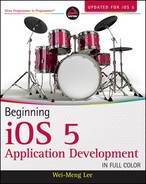SELECTORS
In Objective-C, a selector refers to the name used to select a method to execute for an object. It is used to identify a method. You have seen the use of a selector in some of the chapters in this book. Here is one of them:
//---create a Button view---
CGRect frame = CGRectMake(10, 50, 300, 50);
UIButton *button = [UIButton buttonWithType:UIButtonTypeRoundedRect];
button.frame = frame;
[button setTitle:@“Click Me, Please!”
forState:UIControlStateNormal];
button.backgroundColor = [UIColor clearColor];
[button addTarget:self
action:@selector(buttonClicked:)
forControlEvents:UIControlEventTouchUpInside];
The preceding code shows that you are dynamically creating a UIButton object. In order to handle the event (for example, the Touch Up Inside event) raised by the button, you need to call the addTarget:action:forControlEvents: method of the UIButton class:
[button addTarget:self
action:@selector(buttonClicked:)
forControlEvents:UIControlEventTouchUpInside];
The action: parameter takes an argument of type SEL (selector). In the preceding code, you pass in the name of the method that you have defined — buttonClicked: — which is defined within the class:
-(IBAction) buttonClicked: (id) sender {
//...
}
Alternatively, you can create an object of type SEL and then instantiate it by using the NSSelectorFromString function (which takes a string containing the method name):
NSString *nameOfMethod = @“buttonClicked:”; SEL methodName = NSSelectorFromString(nameOfMethod);
The call to the addTarget:action:forControlEvents: method now looks like this:
[button addTarget:self
action:methodName
forControlEvents:UIControlEventTouchUpInside];
![]() NOTE When naming a selector, be sure to specify the full name of the method. For example, if a method name has one or more parameters, you need to add a “:” in the sector, such as the following:
NOTE When naming a selector, be sure to specify the full name of the method. For example, if a method name has one or more parameters, you need to add a “:” in the sector, such as the following:
NSString *nameOfMethod = @“someMethod:withPara1:andPara2:”;
